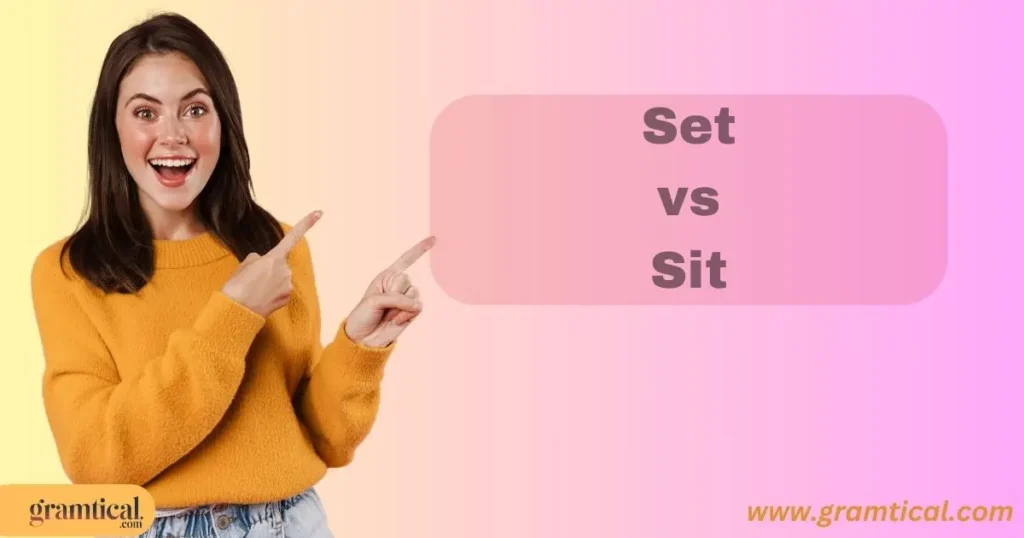- 1. Understanding “Set vs. Sit”
- 2. How to Use “Set vs. Sit” Correctly
- 3. Common Mistakes and How to Avoid Them about “Set vs. Sit”
- Connector vs. Connecter: Which Spelling to Use?
- 4. A Comparison: “Set vs. Sit”
- 5. What’s the Difference Between “Set vs. Sit”?
- 6. A Quick Comparison Table About “Set vs. Sit”
- 7. Why Does This Matter?
- 8. Practical Exercises: Set vs. Sit
- Key Insight
- Conclusion
“Master the difference between ‘set’ and ‘sit’ with easy examples. Learn when to use each verb correctly in English!”
“Set” and “sit” are two commonly confused verbs in English, but their meanings and uses are quite distinct. While “set” refers to placing or arranging something, “sit” involves taking a seated position. Understanding their correct usage is crucial for clear communication, and this guide simplifies the rules with examples for 2025 learners.
The English language is full of nuances that often confuse even native speakers. One such pair of words that causes confusion is “set“ and “sit.”
While they are similar in meaning, they are used in completely different contexts.
Understanding the difference between them is key to mastering English grammar and improving both your spoken and written communication.
This article will help you understand how to correctly use set and sit, so you can speak and write with more precision.
By explaining the correct contexts for both words, providing examples, and clarifying common mistakes, we will ensure you feel confident in your understanding of these two important verbs.
Whether you’re writing an email or engaging in casual conversation, getting this distinction right can make a big difference.
Knowing when and how to use set versus sit correctly is essential not just for clarity, but for effective communication. We’ll dive deep into each word’s proper usage, compare the two, and offer tips to avoid common mistakes, so you’re equipped to handle them with ease.
1. Understanding “Set vs. Sit”
Conversation Explained with Examples
Let’s start by looking at how set and sit are used in everyday conversations.
Imagine a situation where you’re at a meeting, and your colleague asks, “Where should we put the report?” In this case, you would respond by saying, “I will set it on the table.”
In this example, set is used to describe the act of placing or arranging something in a specific location. On the other hand, if your colleague were to ask, “Where should I sit?” the correct response would involve using sit, as it refers to the act of placing oneself in a seated position.
The key takeaway here is that set typically involves putting something in a specific place, while sit involves placing oneself down in a seat.
2. How to Use “Set vs. Sit” Correctly

Explanation, Scenario, Subject, and Email Example
Let’s break down the proper usage of set and sit in different scenarios to ensure you’re clear on when to use each verb.
- Set: This verb is used when talking about placing or arranging something in a specific position, usually with an object.
- Example: “Please set the book on the shelf.”
- In this case, set means to place the book in a particular spot on the shelf.
- Sit: This verb is used when referring to the action of placing oneself in a seated position.
- Example: “Please sit in the chair.”
- Here, sit refers to the person themselves moving to a seated position in the chair.
Email Example:
Subject: Request to Set the Meeting Time
Hi Sarah,
I wanted to confirm that we will set the meeting for 3:00 PM tomorrow. Also, please make sure to remind everyone to sit down promptly when the meeting starts so we can begin on time.
Looking forward to your response.
Best,
James
In the email above, set refers to establishing the time for the meeting, while sit refers to the physical act of sitting down.
3. Common Mistakes and How to Avoid Them about “Set vs. Sit”
Focus Keyword and Examples
While set and sit are quite distinct, many people still get them mixed up. Below are three common mistakes people make and how to avoid them:
- Incorrect: “I will sit the book on the table.”
- Correct: “I will set the book on the table.”
- In this case, the action is about placing the book down, so set is the correct choice.
- Incorrect: “Please set on the chair.”
- Correct: “Please sit on the chair.”
- Here, sit is used because it refers to the action of sitting down.
- Incorrect: “I need to sit the table for dinner.”
- Correct: “I need to set the table for dinner.”
- Set is used when referring to arranging things like dishes or utensils on a table.
To avoid these mistakes, remember: set involves placing or arranging something, while sit is about seating oneself.
Connector vs. Connecter: Which Spelling to Use?
4. A Comparison: “Set vs. Sit”
Examples
Let’s compare set and sit in different contexts:
- Set: “I need to set the alarm for 7 AM.”
- Here, set refers to adjusting or arranging something (the alarm) to a specific time.
- Sit: “I like to sit by the window when reading.”
- In this case, sit refers to physically sitting down in a particular spot.
- Set: “She will set the chairs for the event.”
- This refers to placing or arranging the chairs in preparation for the event.
As you can see, set typically refers to the act of positioning or arranging something, while sit refers to placing yourself in a seated position.
5. What’s the Difference Between “Set vs. Sit”?
Examples
- Set: “Can you set the plates on the table?”
- Set refers to placing the plates in position on the table.
- Sit: “Please sit in the front row.”
- Sit here refers to taking a seat.
- Set: “I need to set the time for the meeting.”
- Set means to establish or arrange the time.
The key difference lies in the action: set is about positioning something or preparing an object, while sit is about physically placing oneself down in a seated position.
6. A Quick Comparison Table About “Set vs. Sit”
|
Word |
Meaning |
Example |
|
Set |
To place, arrange, or establish something |
“Please set the books on the shelf.” |
|
Sit |
To place oneself in a seated position |
“Please sit down in the chair.” |
7. Why Does This Matter?
Correctly using set and sit can significantly improve your communication skills. Using these words appropriately not only ensures clarity but also prevents misunderstandings.
Whether you are giving instructions, writing emails, or engaging in conversations, choosing the correct verb makes your language more precise and effective.
Many people are unaware of the difference between these two verbs, but once you understand their distinct meanings and proper usage, you’ll be able to avoid common errors and communicate with confidence.
8. Practical Exercises: Set vs. Sit
Here are five exercises to help reinforce your understanding of set and sit:
- Write a sentence using set to describe placing something on a surface.
- Write a sentence using sit to describe someone sitting in a chair.
- Choose the correct verb: “Please _______ the document on my desk.”
- Choose the correct verb: “I need to _______ down before I faint!”
- Write a short paragraph where you use both set and sit correctly.
Key Insight
What is the difference between “set” and “sit”?
Set refers to placing or arranging something in a position, while sit refers to the action of seating oneself.
Can “set” and “sit” be used in the same context?
No, they are used in different contexts: set refers to placing an object, and sit refers to positioning oneself in a seated position.
Why do people confuse “set” and “sit”?
The confusion usually arises because both verbs can describe the act of positioning, but set is used for objects and sit is for people.
How can I remember when to use “set” vs. “sit”?
If you’re referring to an object or arranging something, use set. If you’re talking about placing yourself in a seated position, use sit.
Can “set” be used for people?
Yes, set can also be used when referring to arranging things in preparation, such as setting the stage or setting the dinner table.
Conclusion
In conclusion, understanding the correct usage of set and sit is vital for clear communication in English.
By using these verbs correctly, you ensure that your writing and speaking are accurate and effective. Remember: set is about placing objects, while sit is about seating yourself.
The distinction between “set” and “sit” lies in their meanings and grammatical roles. “Set” is an action of placing something, whereas “sit” refers to the act of being seated. By practicing these differences, you’ll avoid confusion and use both verbs confidently in your English conversations.

Hi! I’m Lauren Reynolds: I make English grammar fun and easy to learn. At gramtical.com, I provide simple guides to help you improve your grammar.

